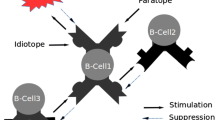Abstract
In this paper, an optimization method that provides quick response using artificial immune system, is proposed and applied to a mobile robot for trajectory tracking. The study focuses on the immune theory to derive a quick optimization method that puts emphasis on immunity feedback using memory cells by the expansion and suppression of the test group rather than to derive a specific mathematical model of the artificial immune system. Various trajectories were selected in mobile environment to evaluate the performance of the proposed artificial immune system. The global inputs to the mobile robot are reference position and reference velocity, which are time variables. The global output of mobile robot is a current position. The tracking controller makes position error to be converged to zero. In order to reduce position error, compensation velocities on the track of trajectory are necessary. Input variables of fuzzy are position errors in every sampling time. The output values of fuzzy are compensation velocities. Immune algorithm is implemented to adjust the scaling factor of fuzzy automatically. The results of the computer simulation proved the system to be efficient and effective for tracing the trajectory to the final destination by the mobile robot.


















Similar content being viewed by others
References
Abdalla TY, Hamzah MI (2013) Trajectory tracking control for mobile robot using wavelet network. Int J Comput Appl 74(3):32–37
Chun JS, Kim MK, Jung HK, Hong SK (1997) Shape optimization of electromagnetic devices using immune algorithm. IEEE Trans Magn 33(2):1876–1879
Dipankar D, Fernando N (2008) Immunological computation: theory and applications. CRC Press, Boca Raton
Duan QJ, Wang RX, Feng HS, Wang LG (2005) Applying synthesized immune networks hypothesis to mobile robots. In: Autonomous Decentralized Systems, IEEE Proc, 69–73
Fahimi F (2009) Autonomous robots: modeling, path planning, and control. Springer, New York
Gao W (2004) Fast immunized evolutionary programming. In Machine Learning and Cybernetics, IEEE Int Conf, 1:198–203
Jayakody JASS, Munagamage R, Munasinghe KDKM, Muhandiram TMMP, Premarathna PAIN, and Rajakaruna RMTP (2015) Design and development of an omni-directional wheeled mobile roBOT. International Research Symposium on Engineering Advancements 2015 (RSEA 2015), 208–210
Jerne NK (1973) The immune system. Sci Am 229(1):52–60
Jerne NK, Cocteau J (1984) IdIOTypic networks and other preconceived ideas. Immunol Rev 79(1):5–24
Kim S, Park C (2005) Optimal tracking controller for an autonomous wheeled mobile robot using fuzzy genetic algorithm. In ICMIT 2005: Cont Sys and Robo 60422C-60422C, https://doi.org/10.1117/12.664653
Kim SH, Park C, Harashima F (2001) A self-organized fuzzy controller for wheeled mobile robot using an evolutionary algorithm. IEEE Trans Ind Electron 48(2):467–474
Leandro N, Castro D, Jonathan T (2002) Artificial immunities: a new computational intelligence approach. Springer-Verlag Berlin, Heidelberg
Lin P, Abney K, Bekey G (2011) Robot ethics: mapping the issues for a mechanized world. Artif Intell 175(5):942–949
Luh GC, Liu WW (2008) An immunological approach to mobile robot reactive navigation. Appl Soft Comput 8(1):30–45
Meshref H, VanLandingham H (2000) Artificial immune systems: application to autonomous agents. In Systems, Man, and Cybernetics, 2000 IEEE Int Conf, 1: 61–66
Nguyen QH, Vu H, Tran TH, Nguyen QH (2017) Developing a way-finding system on mobile robot assisting visually impaired people in an indoor environment. Multimedia Tools and Applications 76(2):2645–2669
Ozcelik S, Sukumaran S (2011) Implementation of an artificial immune system on a mobile robot. Procedia Computer Science 6:317–322
Pedraza C, Castillo J, Martínez JI, Huerta P, Bosque JL, Cano J (2011) Genetic algorithm for Boolean minimization in an FPGA cluster. J Supercomput 58(2):244–252
Pham TT, Mulhem P, Maisonnasse L, Gaussier E, Lim JH (2012) Visual graph modeling for scene recognition and mobile robot localization. Multimedia Tools and Applications 60(2):419–441
Rawlik K, Zarubin D, Toussaint M, Vijayakumar S (2018) An approximate inference approach to temporal optimization for robotics. In: Robotics Research, 145–162
Razafimandimby C, Loscri V, and Vegni AM (2016, April) A neural network and IoT based scheme for performance assessment in Internet of Robotic Things. In Internet-of-Things Design and Implementation (IoTDI), 2016 IEEE First International Conference on. 241–246
Russo M (2000) Genetic fuzzy learning. Evolutionary computation. IEEE Trans 4(3):259–273
Sheth PN, Uicker JJ (1971) A generalized symbolic notation for mechanisms. J Manuf Sci Eng 93(1):102–112
Siegwart R, Nourbakhsh IR (2004) Autonomous mobile robots. Massachusetts Institute of Technology
Wang S, Zhao H, and Hao X (2015, November) Design of an intelligent housekeeping robot based on IOT. In Intelligent Informatics and Biomedical Sciences (ICIIBMS), 2015 International Conference on. 197–200
Whitbrook AM, Aickelin U, Garibaldi JM (2007) IdIOTypic immune networks in mobile-robot control. Systems, Man, and Cybernetics, Part B: Cybernetics, IEEE Trans 37(6):1581–1598
Yong B, Zhang G, Chen H, Zhou Q (2016) Intelligent monitor system based on cloud and convolutional neural networks. J Supercomput:1–17
Acknowledgments
This research was supported by the National Research Foundation of Korea (NRF) grant funded by the Korea Government (MISP)(2016R1A4A1011761). This research was conducted by the grant of Kwangwoon University, 2018.
Author information
Authors and Affiliations
Corresponding author
Additional information
Publisher’s Note
Springer Nature remains neutral with regard to jurisdictional claims in published maps and institutional affiliations.
Rights and permissions
About this article
Cite this article
Cho, S., Shrestha, B., Jang, W. et al. Trajectory tracking optimization of mobile robot using artificial immune system. Multimed Tools Appl 78, 3203–3220 (2019). https://doi.org/10.1007/s11042-018-6413-7
Received:
Revised:
Accepted:
Published:
Issue Date:
DOI: https://doi.org/10.1007/s11042-018-6413-7




